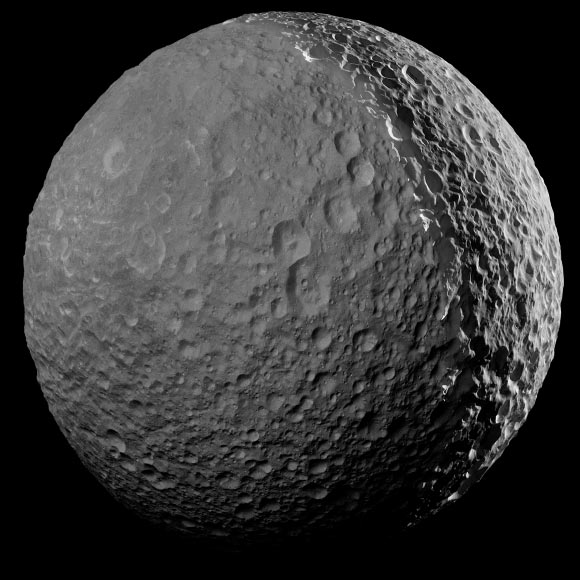Mimas, a small moon of Saturn, is heavily cratered and lacks the typical characteristics of an ocean-bearing moon, such as the active surface of Enceladus. However, measurements of Mimas, made by NASA’s Cassini mission, are best explained by an ocean under a relatively thick ice shell. In new research, a duo of planetary scientists tried to understand how this ice shell and ocean may have changed with time by modeling the formation of Mimas’ largest impact basin, Herschel.
Mimas’ heavily cratered surface suggests a cold history, but its librations rule out a homogeneous interior. Rather, Mimas must have a rocky interior and outer hydrosphere, which could include a liquid ocean or be fully frozen with a non-hydrostatic core. Image credit: NASA / JPL-Caltech / Space Science Institute.
Mimas is the innermost, and smallest (radius = 198.2 km, or 123 miles), regular moon of Saturn.
The moon’s surface is heavily cratered, and it is easily identified by the large Herschel impact basin.
Tectonic activity on Mimas is sparse, and there is no evidence of past or present volcanism.
“In the waning days of NASA’s Cassini mission to Saturn, the spacecraft identified a curious libration, or oscillation, in Mimas’ rotation, which often points to a geologically active body able to support an internal ocean,” said Dr. Alyssa Rhoden, a researcher at Southwest Research Institute.
“Mimas seemed like an unlikely candidate, with its icy, heavily cratered surface marked by one giant impact crater that makes the small moon look much like the Death Star from Star Wars.”
“If Mimas has an ocean, it represents a new class of small, ‘stealth’ ocean worlds with surfaces that do not betray the ocean’s existence.”
Dr. Rhoden and Purdue University graduate student Adeene Denton wanted to better understand how a heavily cratered moon like Mimas could possess an internal ocean.
They modeled the formation of the Hershel impact basin using iSALE-2D simulation software.
The models showed that Mimas’ ice shell had to be at least 55 km (34 miles) thick at the time of the Herschel-forming impact.
In contrast, observations of Mimas and models of its internal heating limit the present-day ice shell thickness to less than 30 km (19 miles) thick, if it currently harbors an ocean.
These results imply that a present-day ocean within Mimas must have been warming and expanding since the basin formed.
It is also possible that Mimas was entirely frozen both at the time of the Herschel impact and at present.
However, the authors found that including an interior ocean in impact models helped produce the shape of the basin.
“We found that Herschel could not have formed in an ice shell at the present-day thickness without obliterating the ice shell at the impact site,” said Denton, who is now a postdoctoral researcher at the University of Arizona.
“If Mimas has an ocean today, the ice shell has been thinning since the formation of Herschel, which could also explain the lack of fractures on Mimas.”
“If Mimas is an emerging ocean world, that places important constraints on the formation, evolution and habitability of all of the mid-sized moons of Saturn.”
“Although our results support a present-day ocean within Mimas, it is challenging to reconcile the moon’s orbital and geologic characteristics with our current understanding of its thermal-orbital evolution,” Dr. Rhoden said.
“Evaluating Mimas’ status as an ocean moon would benchmark models of its formation and evolution.”
“This would help us better understand Saturn’s rings and mid-sized moons as well as the prevalence of potentially habitable ocean moons, particularly at Uranus.”
“Mimas is a compelling target for continued investigation.”
The results were published in the journal Geophysical Research Letters.
_____
C.A. Denton & A.R. Rhoden. Tracking the Evolution of an Ocean Within Mimas Using the Herschel Impact Basin. Geophysical Research Letters, published online December 26, 2022; doi: 10.1029/2022GL100516




